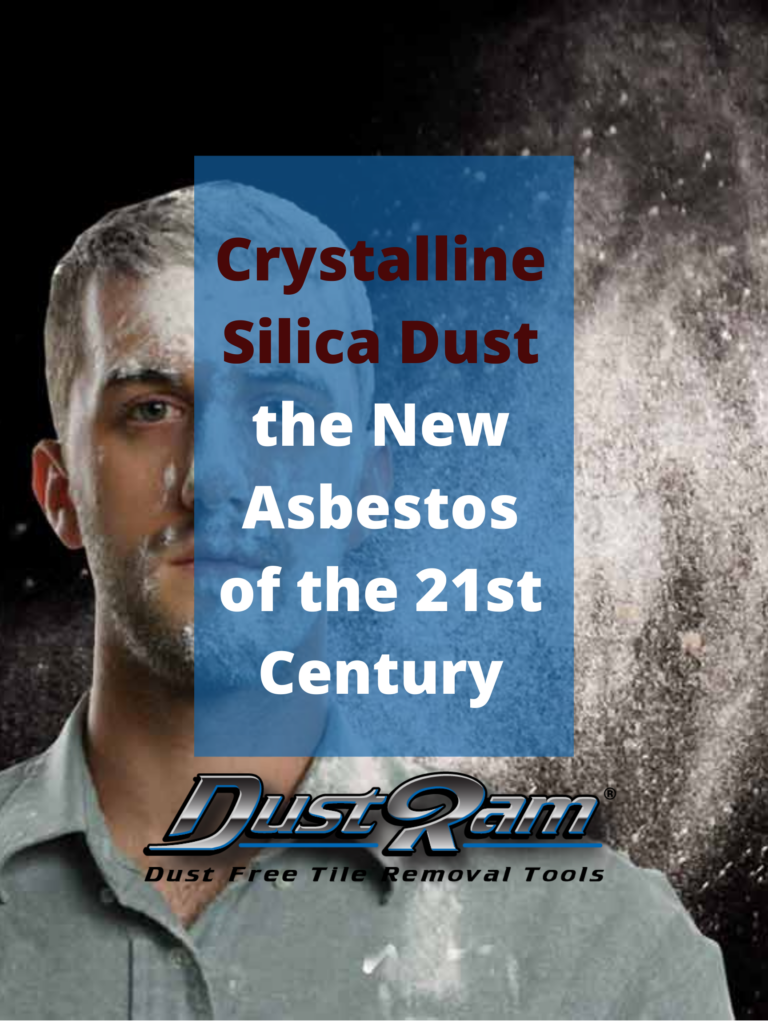
The Importance of Indoor Air Quality: Crystalline Silica Dust Edition
The Environmental Protection Agency (EPA) states that indoor air pollution can be 2 to 5 times higher than outdoor pollution levels. In some cases, indoor pollution can be 100 times more dangerous and damaging than the equivalent of outdoor pollution.
Modern-day lifestyles necessitate spending significant time indoors, so we must take care of our indoor air quality at all times to prevent our health and our loved ones. Follow along with DustRam® to learn about the importance of indoor air quality and the ramifications of exposure to crystalline silica dust from home remodeling projects.
How Does Air Quality Impact Your Everyday Life?

Health and Immunity
High-quality indoor air enhances our health. Given that we spend most of our time indoors, having high-quality indoor air ensures you do not compromise your immune system or normal bodily function. Poor air quality exposes you to particles and air molecules damaging to your health.
Diseases and Illnesses
As you’ll see below, poor air quality is associated with a myriad of health issues that affect your immune system, respiratory system, eyes, and much more. Ensuring you have high-quality air at home, protects you and your family from such ailments.
Your Life At Home
Whether you’re working from home or relaxing after a long work week, having fresh air flow throughout the house improves your at-home experience. Fresh air enhances your productivity, sleep quality, relaxation, and more.
Related Post: Crystalline Silica Dust – the New Asbestos of the 21st Century
What Causes Indoor Air Pollution?
Certain Home Remodeling and Renovation Projects

There are many indoor air pollutants to be concerned about but crystalline silica dust is one that is most common in home remodeling and renovation projects. More specifically, during a retiling project, you should be concerned about pollution resulting from the removal through outdated processes.
While there are many sources of indoor pollution, respirable crystalline silica dust associated with retiling the home, is particularly dangerous as they cause serious respiratory-related diseases. Methods like traditional and virtually dustless tile removal release dust back into your home.
What is Respirable Crystalline Silica and How Will it Affect Your Life?

OSHA defines crystalline silica as a mineral found in numerous construction materials, including concrete, stones, sand, ceramics, tiles, mortar, and bricks. The mineral is generally safe to interact with when it’s a material composition. However, when these construction materials are worked on, they the dangerous create dust. This dust exposes individuals around the workplace to carcinogenic silica particles.
In the case of retiling projects, ripping up old tile and clearing the mortar from the base creates and spreads dust around, especially when using inappropriate tool and outdated techniques and methods.
Related Post: The Dangers of Crystalline Silica Dust
How You Can Be Exposed to Respirable Crystalline Silica During a Retiling Project
The US Department of Labor estimates that about 2.2 million people get exposed to crystalline silica dust in the workplace every year. The high number of people exposed to silica dust is due to the wide variety of processes that create the dust at a job site.
Subjecting materials that contain crystalline silica to cuts, chipping, sawing, drilling, crushing, or grinding, produces minute particles of silica dust that are about a hundred times smaller than typical grains of sand.
These particles of silica are commonly referred to as respirable silica dust. With outdated techniques and processes, contractors are exposing their workers and customers to this extremely dangerous dust. Companies don’t have the proper technology to filter the dust and capture it – to prevent it from touching the air you breathe.
Instead the dust is released back into your home from tens to hundred of pounds. The dust circulates through the home via the HVAC, pervading your belongings and ending up in your lungs.
Health Issues Associated With Indoor Pollution (Especially Crystalline Silica Dust)

Scientists and medical practitioners agree that indoor air quality impacts your health. To be precise, indoor pollution can harm your health and long-term well-being. Depending on the air pollutant in question, indoor pollution can irritate the nose, throat, and nose, cause headaches, dizziness, fatigue, respiratory diseases, and can even cause cancer in the lungs.
In case of crystalline silica exposure, you risk getting silicosis, an incurable condition that affects your lungs by reducing their ability to take in oxygen. Silicosis also causes permanent damage to the lungs.
When the silica dust becomes lodged into the lungs, the particles cause progressive inflammation and scar the lungs, which can be fatal. Chronic silicosis usually sets in a long period after exposure, typically 10 years later. Symptoms of chronic silicosis include fatigue, a persistent cough, chest pain, and shortness of breath.
According to the CDC, exposure to crystalline silica also causes other serious ailments, including kidney disease, chronic Obstructive Pulmonary Disease (COPD), autoimmune disease, and lung cancer.
As you might appreciate, avoiding the aforementioned ailments and health issues that come with exposure to crystalline silica dust is paramount. That’s why it’s essential to ensure your indoor air quality is never compromised, especially when working on renovations and improvements involving masonry, concrete, tiles, and other related construction materials.
Dust Free Floor Removal is the Solution
Keep Your Family and Pets Safe from the Carcinogenic Tile Dust

Our main goal is to help our homeowners, tenants, and contractors efficiently remove tiles while keeping the space dust-free. There are numerous benefits to our systems, including:
#1. Dust-Free Removal Process and Technology
Unlike traditional methods of tearing down tiles or the relatively inefficient dustless methods and systems, our dust-free method not only filters but also captures and contains 99.99% of the crystalline silica dust produced while removing tiles. To achieve a truly dust-free tile removal result, our system suctions dust at the source using our technologically advanced vacuums. We do not release dust anywhere near your home. You can rest assured that your household will benefit from 50 times better air quality than permitted by OSHA standards.
#2. Healthy Indoor Space And Air
A notable benefit of our system is the improved air quality, which protects your health. By capturing the dust as soon as it is released, we guarantee that no dust is released into the air. Importantly, no dust ends up on your ceiling, air ducts and vent, clothes, shoes, and, importantly, your lungs.
#3. OSHA Compliant
Our systems and processes tick all the boxes. We achieve better air quality than is required by OSHA. In fact, our systems will protect you from exposure to silica dust. Not only is our system OSHA Compliant, we exceed it by 50 times. We don’t just filter the dust… we CAPTURE it and that is what differentiates a dust free result from the outdated processes in the industry.
#4. Cost-Effective Removal Process
Our dust-free processes and equipment have the advantage of being cost-effective. For instance, we do not need to construct barriers to mitigate dust, and our equipment allows us to work much faster. But perhaps the most important cost-saving consideration is the lack of post-clean-up.
Given that our tile removal processes do not release dust back in your home, you do not have to incur extra costs in the clean-up process. This means no professional cleaning sessions are needed and most importantly, no hospital bills for respiratory diseases.
How Our System Ensures The Tile Removal Process Is Dust-Free Every Step of the Way

We execute using advanced technologies and processes to achieve a truly dust-free tile removal, thereby ensuring your indoor air quality remains excellent. We fully comprehend the dangers of crystalline silica in the home. As such, we go above and beyond to ensure we capture all the crystalline silica produced while tearing up the old tiles. We will never compromise your air quality.
High CFM
Our patented vacuum system was made for the sole purpose of the capturing the dust to alleviate the stress that came with the mess and exposure. Our vacuums are unlike any others out in the market.
No Need For Manually Purging
While traditional and dustless tile removal systems need to purge filters frequently and manually, our system does this automatically every 5 seconds. Waiting for the vacuum to clog up enough to notice a drop in suction, force exposes you to the dust. Our system works continuously, to suction the dust and it is the most efficient technology out on the market.
Our Equipment Collects and Suctions Dust at the Chisel
Unlike other systems, our equipment and methods are designed to capture and suction dust at the moment it is created. We capture silica at the chisel right after it’s been produced, thereby denying the dust opportunity or time to spread around your home. Our approach is more efficient and effective, and we leave your home with clean indoor air.
Put Your Health First
Put Your Health First. Don't Let Silica Dust Live in Your Home
The importance of quality indoor air cannot be overstated enough. Do not compromise the safety of your family during a retiling project. Work with a team that uses dust-free tile removal methods to keep you safe from crystalline silica dust at bay.
For more related content, the latest news and trends, and more, be sure to visit our flooring removal blog.







